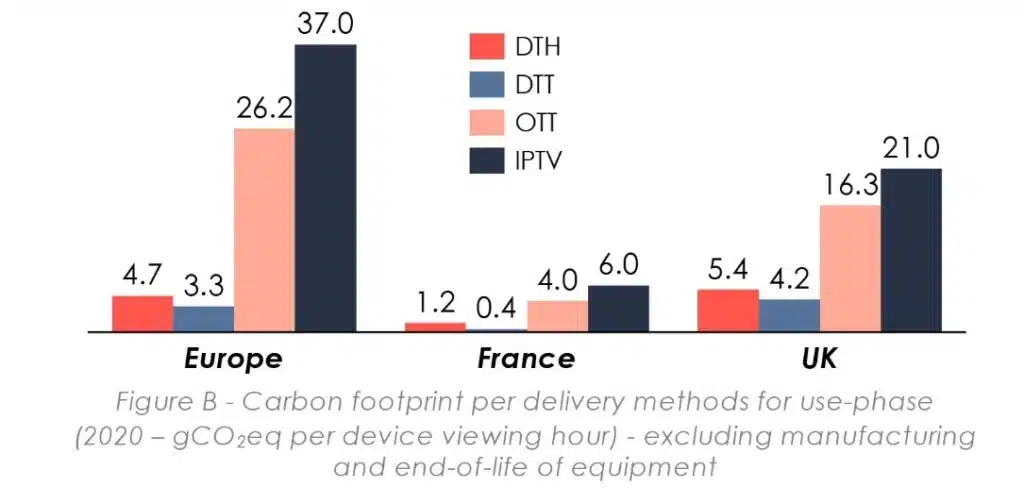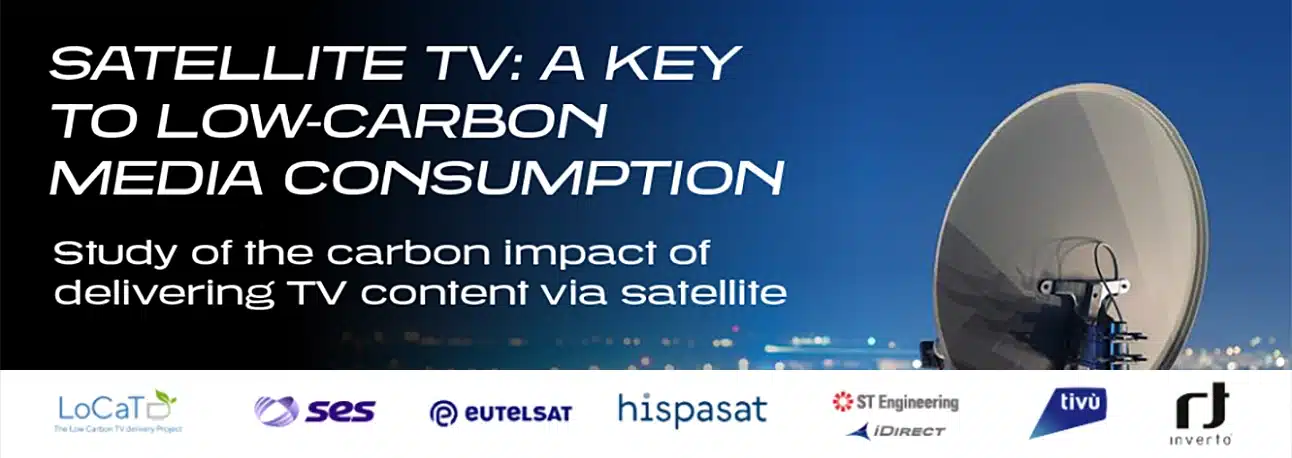The global push for sustainability is reshaping every industry, and media distribution is no exception. While streaming services often dominate the conversation, a new study reveals a powerful truth: satellite TV distribution holds a significant advantage in energy efficiency and boasts a significantly low carbon footprint.
This new study, LoCaT-Sat, conducted by consulting firm Carbone 4 and sponsored by industry players: Intelsat (now part of SES), Eutelsat, Hispasat, ST Engineering iDirect, Inverto and TiVù, extends the original 2021 LoCaT assessment to include satellite TV distribution. The findings provide a clear, data-driven perspective on the environmental performance of various distribution methods. This analysis is a strategic insight for the future of broadcasting, demonstrating that satellite technology is a key player in building a more sustainable media ecosystem. For industry professionals navigating this evolving landscape, these results underscore satellite’s role as a scalable, and highly efficient solution for content distribution.
Hear from the LoCaT-Sat consortium members, shedding light on their perspectives regarding the future of satellite technology and its role in sustainable broadcasting.
Unpacking the LoCaT-Sat Study
To ensure precision and comparability, the LoCaT-Sat study was built on the same foundational principles as the original LoCaT project. It applied an attributional life-cycle assessment (LCA) approach, focusing on the energy consumed during the “use phase” of content distribution. This scope encompasses the entire satellite TV distribution chain, also known as Direct-to-Home (DTH), from the uplink sites that transmit the signal, to the satellites in geostationary orbit (GEO), and finally to the in-home equipment used by consumers.
The study’s functional unit is one hour of television viewing on a single device, providing a standardized metric for comparison across different platforms. To maintain consistency, the analysis intentionally excludes the carbon footprint of content production, backhaul transport to the uplink site, and the manufacturing or end-of-life processes for equipment. This focus allows for a direct comparison of the operational energy footprint of satellite, IPTV (Internet Protocol Television), and OTT (Over-the-Top) streaming.
Covering a wide geographical scope that includes Europe (EU28), North America, and Latin America, the study shows regional data and detailed national insights from countries like France, Germany, Italy, Spain, and the UK. This approach provides a global perspective on how satellite TV distribution performs under different energy mixes and consumer habits.
The Verdict: Satellite’s Efficiency
The results of the LoCaT-Sat study are compelling. In Europe, satellite TV distribution proves to be significantly more energy-efficient and less carbon-intensive than its IP-based counterparts.
The European results reveal that for one hour of viewing:
- Satellite TV generates just 6.4 gCO₂e (grams of carbon dioxide equivalent).
- Over-the-Top (OTT) streaming produces 26.2 gCO₂e.
- Managed IPTV accounts for 37 gCO₂e.

This means satellite broadcasting is nearly six times more carbon-efficient than OTT and almost eight times more efficient than managed IPTV. When looking at energy consumption, the difference is just as stark. Satellite TV distribution uses an average of 19.5 Wh per viewing hour, compared to 109 Wh for OTT and 153 Wh for IPTV.
The study also compared satellite against Digital Terrestrial Television (DTT), which recorded 3.3 gCO₂e. While DTT shows a slight edge in this comparison, satellite’s performance places it firmly in the low-carbon category, far ahead of IP-based delivery methods that are often perceived as the default modern solution.
DTH use-phase emissions are higher in North America than in Europe and are expected to remain so, while Latin America currently has lower emissions—but this is likely to change over time. In North America, higher emissions are driven by a more carbon-intensive electricity mix and lower energy efficiency per hour of viewing. This trend is expected to persist in the future.
In contrast, Latin America presently shows lower emissions and electricity consumption during DTH use due to better energy amortization per viewing hour, despite a more carbon-intensive electricity mix and a complete lack of embedded decoders (0% in Latin America vs. 29% in Europe). However, by 2035, this dynamic is likely to reverse. Europe is expected to significantly reduce electricity consumption per hour of DTH viewing, aided by a growing share of embedded decoders (71% in Europe compared to 30% in Latin America).
Dissecting the Emissions: Where Does the Impact Come From?
A critical insight from the study is the breakdown of energy consumption within the satellite TV distribution chain. The analysis shows that the infrastructure responsible for transmission—the uplink sites and the satellites themselves—contributes minimally to the overall carbon footprint.
In fact, over 99% of the electricity usage is attributed to the in-home reception equipment. This includes set-top boxes, amplifiers, and other associated devices. The satellite uplink infrastructure accounts for a mere 0.1 Wh per viewing hour. Geostationary satellites, powered primarily by solar energy once in orbit, are considered to consume no grid electricity during operation, making their use-phase impact negligible.
This finding is pivotal. It demonstrates that the core of satellite transmission technology is inherently energy efficient. The primary driver of emissions is the consumer-side hardware, which presents a clear and actionable opportunity for further environmental improvements.
Optimizing the Last Mile: In-Home Equipment
The concentration of energy use in in-home equipment highlights a crucial area for innovation. The LoCaT-Sat study observed a wide variation in the energy consumption of these devices, ranging from just 7 Wh to 56 Wh per hour of viewing.
Several factors contribute to this variance:
- Device Type: The specific model and age of the set-top box or decoder play a significant role.
- Housing Type: The study found that installations in individual homes are, on average, 3 times more energy-efficient than those in collective housing, which often require additional amplification.
This presents a strategic opportunity for manufacturers and service providers. By developing and promoting more energy-efficient decoders and optimizing installation practices, the satellite industry can further reduce its already low carbon footprint. Encouraging the adoption of the latest, most efficient hardware can drive down energy consumption at a mass scale, solidifying satellite’s position as a sustainable distribution leader.
Decarbonizing Future
The future for satellite TV distribution looks even greener. The LoCaT-Sat study projects that as Europe’s electricity grid continues to decarbonize, the carbon footprint of satellite broadcasting will decrease significantly.
Between 2020 and 2035, while energy usage per viewing hour is expected to remain relatively stable, the associated carbon emissions in Europe are projected to fall dramatically from 4.7 gCO₂e to just 1.3 gCO₂e (in scenarios A,B and C). This and other projections are based on LoCaT Original study assumptions regarding the evolution of the number of TV households. The different scenarios can be consulted in the annexes of the LoCaT-Sat Study.
Efficient Broadcasting
For broadcasters, service providers, and technology partners, these findings provide a powerful narrative. Satellite technology offers a clear path to reducing the environmental impact of content delivery without compromising on reach or quality. By focusing on the continued innovation of in-home equipment and leveraging the ongoing decarbonization of our energy grids, the satellite industry is poised to lead the charge in green broadcasting. The message is clear—when it comes to delivering content efficiently and responsibly to a mass audience, satellite is a solution that truly reaches for the stars.
